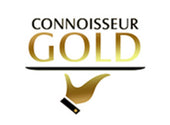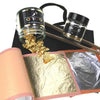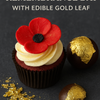The Glittering Tradition: Uses of Silver Leaf in Indian Sweets
- by sam@wrightsoflymm.co.uk User
Introduction: A Sparkle on Every Sweet
If you’ve ever stepped into an Indian sweet shop during festivals like Diwali, Eid, or weddings, you’ve probably noticed something shimmering atop the mithai (sweets). That delicate silver coating—known as silver leaf or vark—is more than just decoration. It’s a centuries-old tradition in India, symbolizing purity, festivity, and abundance.
But silver isn’t the only glittering element in the world of edible decoration. Alongside it, edible gold leaf, gold flakes, gold dust, silver flakes, and silver dust are also used in luxury dining and desserts worldwide. In Indian culture, however, silver leaf has a special place—particularly in sweets like kaju katli, barfi, and malai chop.
This blog dives deep into the history, significance, and uses of silver leaf in Indian sweets, while also exploring its connection to edible gold.
Traditional and Cultural Significance of Silver Leaf
Symbol of Celebration
Silver-coated sweets are almost always associated with joyous occasions. Birthdays, engagements, weddings, and religious festivals often feature sweets decorated with silver foil. The sparkle signifies prosperity and wealth—making the sweet not only delicious but also auspicious.
In fact, many families only buy sweets with silver leaf during special occasions, reinforcing its image as a luxury garnish reserved for meaningful moments.
Purity and Rituals
Traditionally, silver leaf was believed to have purifying properties. In ancient Ayurveda, silver was considered cooling and beneficial for balancing body heat. The thin foil was sometimes applied not just to sweets but also to fruits, betel leaves (paan), and even certain medicines.
This association with purity and wellness is one reason why silver-coated sweets remain deeply rooted in Indian culture.
Health Beliefs Around Silver Leaf
While there’s debate over the health benefits of silver, it has been part of traditional medicine in India for centuries.
-
Ayurvedic Beliefs: Silver, like gold, was sometimes powdered and used in formulations to boost immunity and vitality.
-
Modern Perspectives: Pure edible silver leaf is considered safe for consumption. It’s inert and passes through the body without being absorbed.
-
Cautionary Notes: Excessive ingestion of silver (particularly in supplement form, not culinary leaf) can cause argyria, a rare condition that turns the skin bluish-grey. But the tiny amount used in sweets is far from harmful.
So while some claim “silver is healthy”, most experts agree its primary role in sweets is aesthetic, with negligible nutritional impact.
Types of Sweets That Use Silver Leaf
Silver leaf is versatile and can be found on many varieties of Indian mithai. Some of the most iconic include:
Kaju Katli
Perhaps the most famous silver-coated sweet, kaju katli is made from cashews, sugar, and ghee, shaped into diamond slices, and finished with a glowing silver film. No box of Diwali sweets feels complete without it.
Barfi
From plain milk barfi to pistachio, coconut, or chocolate versions, silver foil is often used to make these colourful squares even more festive.
Malai Chop (Chenna Toast)
Popular in Tamil Nadu and Bengal, malai-based sweets sometimes feature a layer of silver to elevate their presentation.
Hyderabadi Delicacies
In Hyderabad, silver-coated sweets are particularly common. The city’s rich culinary traditions often merge Mughal influences, and vark remains a staple in sweet shops.
Practical and Aesthetic Uses of Silver Leaf
Aesthetic Appeal
At its core, silver leaf is a decorative element. Its delicate shimmer makes sweets look more luxurious and festive. A simple cashew fudge turns into a royal treat once it gleams under a silver film.
Affordability of Glamour
Contrary to what one might think, silver leaf isn’t outrageously expensive. Since it’s only a few atoms thick, a single sheet can cover a lot of sweets. This makes it an affordable way for sweet makers to add perceived value.
Edibility
Authentic silver leaf is edible and safe, provided it’s pure. Unfortunately, cheaper versions sometimes contain impurities or are manufactured with unhygienic methods. Reputable sweet shops ensure the use of certified edible silver.
Regional Variations in Silver-Coated Sweets
Hyderabad
Known for its rich desserts, Hyderabad frequently uses silver leaf in sweets like badam ki jaali and double ka meetha during festivals and weddings.
Tamil Nadu
Some milk-based sweets, especially chenna variations, are adorned with silver foil to enhance their festive appeal.
Northern India
In places like Uttar Pradesh, Delhi, and Rajasthan, silver leaf is almost mandatory on festival favorites such as motichoor ladoos and barfi varieties.
Silver Leaf and Edible Gold: A Luxurious Connection
Silver leaf may be more common in Indian sweets, but it belongs to the same family of edible decorations as gold leaf, gold dust, gold flakes, and even 23ct and 24ct goldleaf sheets used worldwide.
Gold vs. Silver in Food
-
Gold Leaf (23ct or 24ct): A staple in luxury dining, often sprinkled on cakes, cocktails, and haute cuisine.
-
Gold Flakes & Gold Dust: Finishing touches for champagne, chocolates, and gourmet desserts.
-
Silver Flakes & Silver Dust: Used similarly but more accessible and culturally widespread in India.
Shared Symbolism
Both edible gold and silver represent wealth, status, and festivity. In India, silver is more practical for daily celebrations, while gold leaf is often reserved for ultra-premium desserts, luxury chocolates, or fusion recipes.
Modern Trends: From Mithai to Global Desserts
The use of silver leaf isn’t confined to traditional sweets anymore. In recent years:
-
Fusion Desserts: Pastry chefs experiment with silver flakes on cakes, mousses, and macarons.
-
Cocktails: Just like gold dust in champagne, silver dust sometimes finds its way into high-end beverages.
-
International Influence: Inspired by Indian traditions, global chefs have started incorporating edible metals into gourmet experiences.
Is Silver Leaf Really Necessary?
Some food enthusiasts argue that silver foil is unnecessary—it adds no flavour, texture, or significant health benefit. Yet, its role in enhancing presentation and cultural symbolism cannot be denied. For many, a kaju katli without vark simply looks incomplete.
In that sense, silver leaf isn’t about necessity—it’s about tradition, emotion, and the art of making sweets feel special.
Conclusion: A Sparkle That Connects Past and Present
From ancient Ayurvedic texts to modern patisseries, silver leaf has maintained its place as a symbol of festivity, prosperity, and artistry. Whether it’s on a diamond-shaped kaju katli or a Bengali malai chop, that delicate shimmer transforms a simple sweet into a luxurious indulgence.
And while edible gold leaf, gold flakes, and gold dust dominate the global luxury food scene, in India, it’s silver leaf that has stolen hearts for generations. It may be thin, light, and subtle, but its cultural weight is undeniable.
Next time you savor a sweet wrapped in silver, remember—you’re not just eating dessert, you’re tasting a piece of history, tradition, and celebration.






